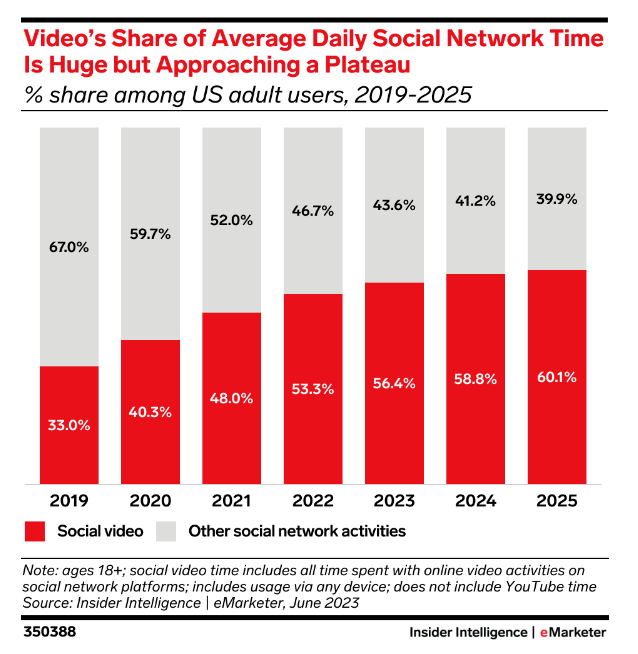At launch, TikTok started out as a mobile-only platform for 15-second videos. Since then, the app has been downloaded 2.7 billion times worldwide — becoming a global phenomenon that changed video marketing forever — and has evolved into so much more. Meanwhile, every major video platform has sought to mimic the success of the short-form video content giant. Instagram Reels, YouTube Shorts and SnapChat Spotlight were all features created in the hopes that other platforms can reach the same audience numbers and engagement rates that have never been achieved before in video marketing:
- Videos under 90 seconds retain 50% of viewers.
- Viewers retain 95% of a message conveyed through video.
- Over 70% of Gen Z watch online videos over three hours daily.
- Video content will make up 82% of global internet traffic by 2025.
These latest social media features have been focused on the same fundamental principle: the average attention span of the human mind only lasts 8.25 seconds — the lowest it’s ever been. Shifting to the “short form, big impact” strategy may be good for reach and brand awareness, but has its drawbacks on long-term engagement and brand loyalty. 8.25 seconds is not a lot of time to make a lasting impression as a brand trying to connect with their consumers in a highly competitive space.
The Downside of Short Content
Today’s consumers are more technologically savvy than ever before. They expect total transparency from the brands they shop from. It takes more than a 15-second video to build that trust and credibility consumers expect today. As brands try to cash in on the latest viral TikTok trends, 13% of consumers feel less loyal to brands and retailers than they did a year ago. Companies that are successful in customer retention are those who invest in a multi-channel customer experience that tells their story, emotionally connects with their customers and caters to an individualized marketing approach.
Short-term video is a critical component to any marketing strategy in today’s digital landscape, but it’s not the only step brands should take. Despite their groundbreaking start, user engagement with short-term video is beginning to plateau — staying at nearly 60% of social media usage being spent on short videos compared to other social media features.

Even TikTok has started to adjust their platform to welcome back longer videos. First they expanded their video time limit to 10 minutes in 2022. In late 2023, TikTok announced an expansion to a 15-minute time limit on videos. In May 2024, TikTok announced they began testing 60-minute video uploads in select markets.
Hello Again, Long-Form Video
There’s no question that video content is a critical part of marketing in 2024. However, with changes to monetization policies, rising advertising costs, plateauing user engagement and decreasing brand loyalty, influencers and advertisers are beginning to question the true value of short-form video as their only form of video marketing. Long-form video content provides brands with the opportunity to expand upon their short, trendy marketing videos that bring brand awareness and nurture viewers into consumers. Many brands hesitate to invest in long-form video marketing because they believe it’s much more costly and viewers won’t watch the whole video anyway.
Do people watch long videos? The statistics may surprise you:
- While TikTok was growing, YouTube remained a long-form video giant with 62% of internet users in the U.S. accessing the platform daily.
- Amazon’s Twitch has a daily audience of 15 million users in 2024.
- 7.6 billion hours of live content were watched across all platforms in the third quarter of 2023.
Paired together with short-form videos, long-form videos are an essential part of video marketing. They provide opportunities for storytelling, customer journey nurturing and customer retention. There’s a common misconception that long-form video is more costly. While they do require a bit more planning, they can be accomplished with the same equipment you’ve already been using with short videos.
Investing in Video Marketing
When planning out your video marketing strategy, think less about the length and more about the content. If content is relevant, useful and makes a connection with its audience, the viewers will stay no matter the length. Successful video strategies integrate content across all relevant platforms seamlessly while tapping into the trends and overall expected tone on each individual platform:
- Threads: short, trendy and experiential text-heavy content
- TikTok: trendy short-form visual & audio
- X ( formerly Twitter): one-on-one outreach and support
- Instagram: more polished, less trendy mix of photo and videos
- Facebook: informational mixed-media content
- YouTube: niche-driven content
Optimizing Video Performance
Going viral for positive reasons is always the goal but the opportunity is rare. The best way to gain a consistent following of your brand’s video content starts with building an infrastructure that is optimized for reach. No matter what channels your brand decides to use for video marketing, there are key factors across all platforms that will help your brand increase views and retention, including:
- Eye-catching thumbnails
- Keyword research-driven video descriptions
- Relevant hashtags
- Accessibility (i.e. video captions)
Video marketing is not going away anytime soon. In fact, all brands should consider enhancing their video marketing efforts in 2024 and beyond. With a proper strategy, your brand’s investment into short and long-form video content will increase brand awareness, improve customer loyalty and drive more revenue.
Katava Marketing is a full-service marketing agency that provides world-class marketing strategy and support to businesses of all sizes. With an in-house video department, we are devoted to helping you deliver high-quality video content that will drive results. Contact us today at (973) 998-8008 or contact us to get started.





